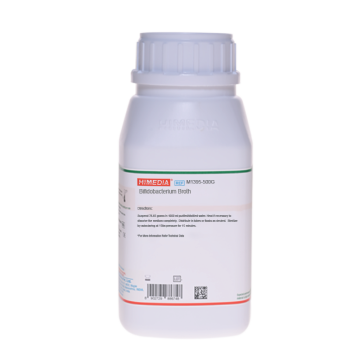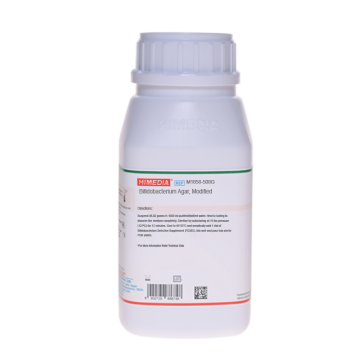 Your enquiry has been submitted
Your enquiry has been submitted
Bifidobacterium Agar
Intended Use:
Recommended for the cultivation and maintenance of numerous Bifidobacterium species.
Composition**
| Ingredients | g/L |
|---|---|
| Special peptone | 23.000 |
| Sodium chloride | 5.000 |
| Dextrose (Glucose) | 5.000 |
| Starch, soluble | 1.000 |
| L-Cysteine hydrochloride | 0.300 |
| Agar | 15.000 |
| Final pH (at 25°C) | 6.8±0.2 |
**Formula adjusted, standardized to suit performance parameters
Directions
Suspend 49.3 grams in 1000 ml purified / distilled water. Mix well and heat to boiling to dissolve the medium completely. Distribute in tubes or flasks as desired. Sterilize by autoclaving at 15 lbs pressure (121°C) for 15 minutes. Mix well and pour into sterile Petri plates.
Principle And Interpretation
The genus Bifidobacterium is the third most numerous bacterial populations found in the human intestine after Bacteroides and Eubacterium. It is an anaerobic bacteria that makes up the gut microbial flora. It resides in the colon and have health benefits for their hosts. Bifidobacteria are also associated with lower incidences of allergies (1,2). Bifidobacterium Agar is used for the cultivation and maintenance of Bifidobacterium species (3).
Special peptone provides essential growth nutrients. Starch acts as protective colloid and shields organisms from harmful substances present in the medium. Glucose is the energy source and sodium chloride maintains isotonic conditions. L-Cysteine hydrochloride helps in creating reduced conditions required for the growth of Bifidobacteria.
Type of specimen
Clinical samples- faeces; Dairy samples.
Specimen Collection and Handling:
For clinical samples follow appropriate techniques for handling specimens as per established guidelines (4,5). For dairy samples, follow appropriate techniques for sample collection and processing as per guidelines (6,7). After use, contaminated materials must be sterilized by autoclaving before discarding.
Warning and Precautions :
In Vitro diagnostic Use. For professional use only. Read the label before opening the container. Wear protective gloves/protective clothing/eye protection/ face protection. Follow good microbiological lab practices while handling specimens and culture. Standard precautions as per established guidelines should be followed while handling clinical specimens. Safety guidelines may be referred in individual safety data sheets.
Limitations :
- Due to variable nutritional requirements, some strains may show poor growth on this medium.
- Bifidobacterium species are strict anaerobes, hence condition must be appropriately maintained.
Performance and Evaluation
Performance of the medium is expected when used as per the direction on the label within the expiry period when stored at recommended temperature.
Quality Control
Appearance Cream to yellow homogeneous free flowing powder
Gelling Firm, comparable with 1.5% Agar gel
Colour and Clarity of prepared medium Amber coloured clear to slightly opalescent gel forms in Petri plates
Reaction Reaction of 4.93% w/v aqueous solution at 25°C. pH: 6.8±0.2
pH 6.60-7.00
Cultural Response Cultural characteristics observed after an incubation at 35-37°C for 24-48 hours in an anaerobic conditions.
| Organism | Inoculum (CFU) | Growth | Recovery |
|---|---|---|---|
| Bifidobacterium bifidum ATCC 15696 | 50-100 | good-luxuriant | >=50% |
| Bifidobacterium breve ATCC 15698 | 50-100 | good-luxuriant | >=50% |
| Bifidobacterium infantis ATCC 25962 | 50-100 | good-luxuriant | >=50% |
Storage and Shelf Life
Store between 10-30°C in a tightly closed container and the prepared medium at 20-30°C. Use before expiry date on the label. On opening, product should be properly stored dry, after tightly capping the bottle in order to prevent lump formation due to the hygroscopic nature of the product. Improper storage of the product may lead to lump formation. Store in dry ventilated area protected from extremes of temperature and sources of ignition. Seal the container tightly after use. Product performance is best if used within stated expiry period.
Disposal
User must ensure safe disposal by autoclaving and/or incineration of used or unusable preparations of this product. Follow established laboratory procedures in disposing of infectious materials and material that comes into contact with clinical sample must be decontaminated and disposed of in accordance with current laboratory techniques (4,5).
Reference
- Bjorksten B., Sepp E., Julge K., Voor T., and Mikelsaar M., 2001, J. Allergy Clin. Microbiol., Volume 108, Issue 4, 516-520.
- Guarner F., and Malagelada J. R., 2003, The Lancet, Vol. 361, Issue 9356, 8 February 2003, 512-519
- Atlas R. M. 2004, 3rd Edi. Handbook of Microbiological Media, Parks, L. C. (Ed.), CRC Press, Boca Raton.4.
- Isenberg, H.D. Clinical Microbiology Procedures Handbook 2nd Edition.
- Jorgensen, J.H., Pfaller, M.A., Carroll, K.C., Funke, G., Landry, M.L., Richter, S.S and Warnock., D.W. (2015) Manual of Clinical Microbiology, 11th Edition. Vol. 1.
- American Public Health Association, Standard Methods for the Examination of Dairy Products, 1978, 14th Ed., Washington D.C.
- Wehr H. M. and Frank J. H., 2004, Standard Methods for the Microbiological Examination of Dairy Products, 17th Ed., APHA Inc., Washington, D.C.
| Product Name | Bifidobacterium Agar |
|---|---|
| SKU | M1396 |
| Product Type | Regular |
| Physical Form | Powder |
| Origin | Animal |
| Packaging type | HDPE |
| References | 1. Björkstén B., Sepp E., Julge K., Voor T., and Mikelsaar M., 2001, J. Allergy Clin. Microbiol., Volume 108, Issue 4, 516-520. |
| Customized Product Available | No |








